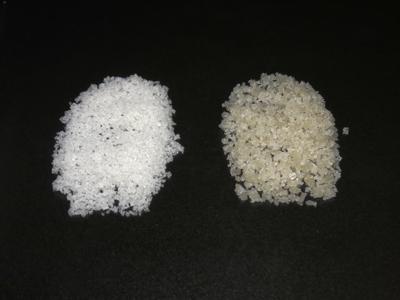Fleur de Sel de Guérande
by Camille
(Minneapolis, MN)

Comparing white fleur de sel (left) with the coarse salt from the salterns of Guérande (Wikimedia Commons)
I use Fleur de Sel de Guérande. I travel a lot for work so I am able to buy it in France. Is that OK?
ANSWER:
Yes, as long as what you are getting is an unrefined natural sea salt that should be moist and mineral-rich rather than a refined, processed salt.
Most of the true natural salts are coarse, moist and off-white.
However, I have seen pictures of Fleur de Sel de Guérande and the salt looked quite white. So I wondered if that is just the way it comes naturally or if it is bleached white through some type of processing.
So, this is what I know thus far about this salt:
According to Wikipedia, “Traditional French fleur de sel is collected off the coast of Brittany, most notably in the town of Guérande (called Fleur de Sel de Guérande), but also in Noirmoutier, Île de Ré and Camargue.”
As you may know, fleur de sel (“flower of salt” in French) is a natural sea salt that is hand harvested by workers who scrape the top layer of salt before it falls to the bottom of large salt pans.
Fleur de Sel de Guérande is made in the same manner of harvesting that the Celts developed nearly 1,000 years ago. However, Guérande’s natural estuaries have most likely been creating salt for thousands of years prior to the land being civilized.
“Fleur de Sel de Guérande is slightly more mineral-rich than Fleur de Sel from Île de Ré, one of the other original Celtic salt-making towns on France's western coast, and far moister and slightly coarser than Fleur de Sel de Camargue, which comes from the south of France,” according to AtTheMeadow.com.
During salt-making season (June to September), the salt raker allows water from the canal to slowly flow into silt ponds that are built into the native clay soil.
The heat of the sun and wind warms the water till it evaporates, the salt content rises until the water becomes brine, which flows into saltpans where the salt crystallizes and is then collected.
The salt raker then harvests two types of salt: (1) coarse salt at the bottom of the pan (sel gris) and (2) small white crystals that form on the surface (fleur de sel).
According to this source, it sounds to me like the whiteness of the salt is naturally occurring, and that it is not processed white. But I suspect that this could vary from manufacturer to manufacturer, so you might want to ask a few questions about the source when you purchase it so that you know that you are getting the real deal and not a processed version.
If you can read French, you might be able to determine this fairly quickly online.
The most important thing about natural salt is to know if it is, in fact, unprocessed with no chemical additives, and if it contains many natural-occurring trace minerals (the real health benefits).
The grey, coarse Celtic sea salt that I am used to and the pink Himalayan salt are known to contain 80 or more trace minerals. This French salt might be just as good (or even better), but I just have not yet found specific information on its mineral content.
Another interesting point about this salt is that the term "flower of salt" was given because as the heaps of white salt are drying, they give off a light scent of violets.
Return from Fleur de Sel de Guérande to Water and Salt
Sign Up for Our Monthly
Newsletter
Visitor Comments
"This was the best and most straight forward info on the net yet. I asked a question and got an answer that made sense. Thank you so much!" - Linderlinder
FINALLY!!! I have been wondering about this for years with no 'solid' answer. This is exactly what I've been wanting to know! Thank you for this share..." by Andy
"Thank you for the information, Nancy. I appreciate it. Your article and findings are very helpful, referring to dehydration." - Carolyn
"Lemon water is one drink both my wife and I can't drink. It upsets our stomachs. We are in our sixties and in very good health—well, better health now that we drink about 2 liters plus of water each day. It has made so much difference to our digestive systems and recovery every day. Thank you for your website and effort." - Rod



